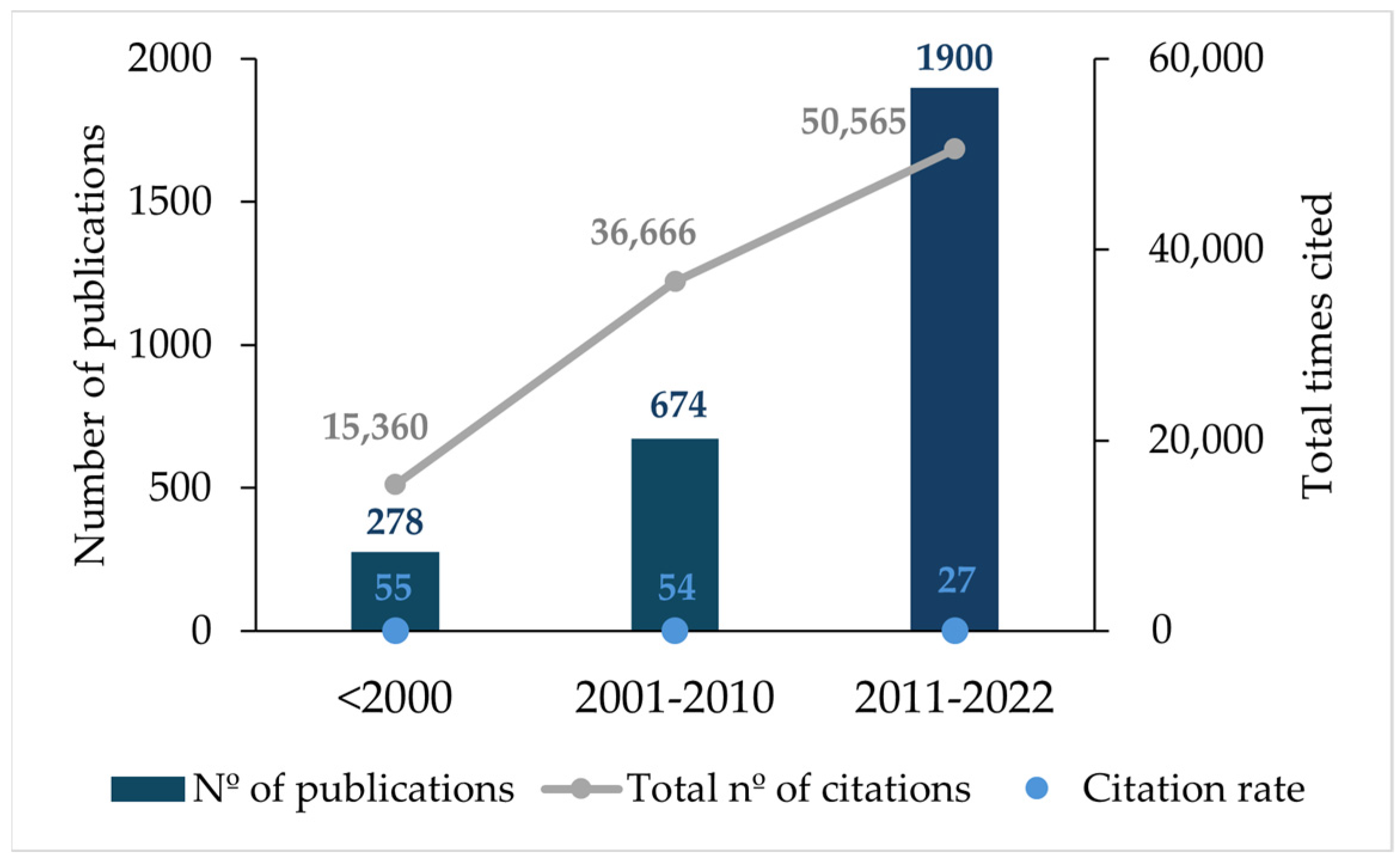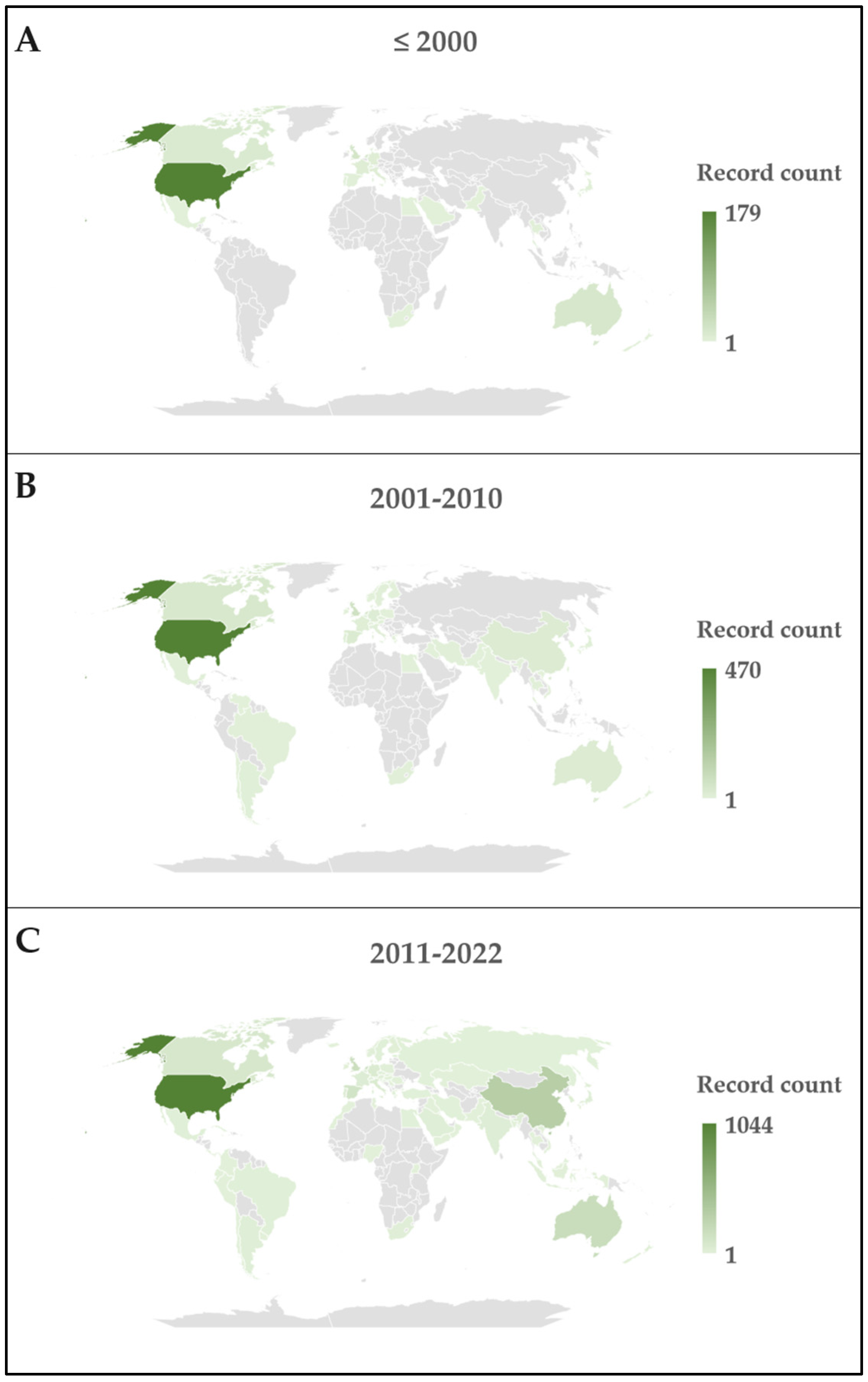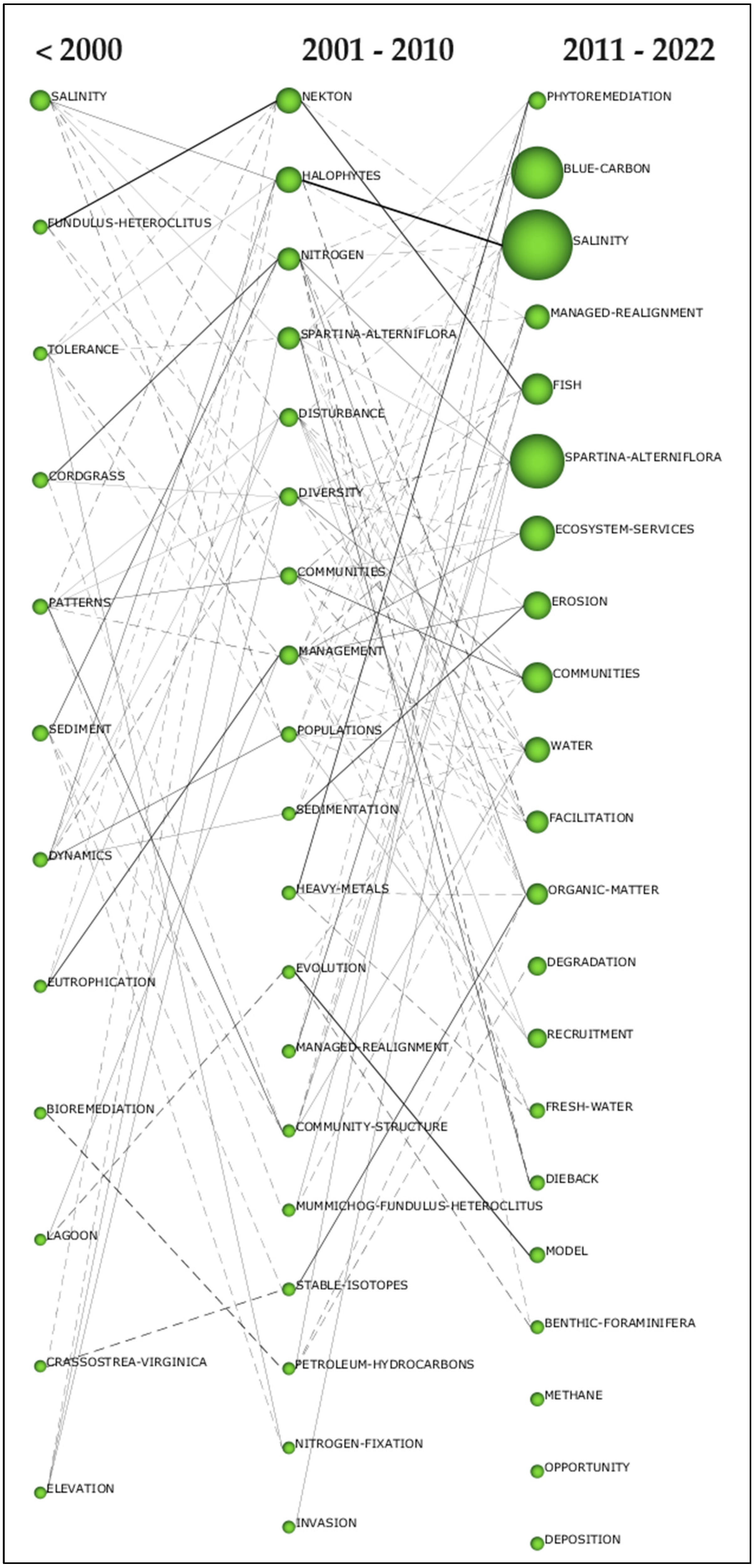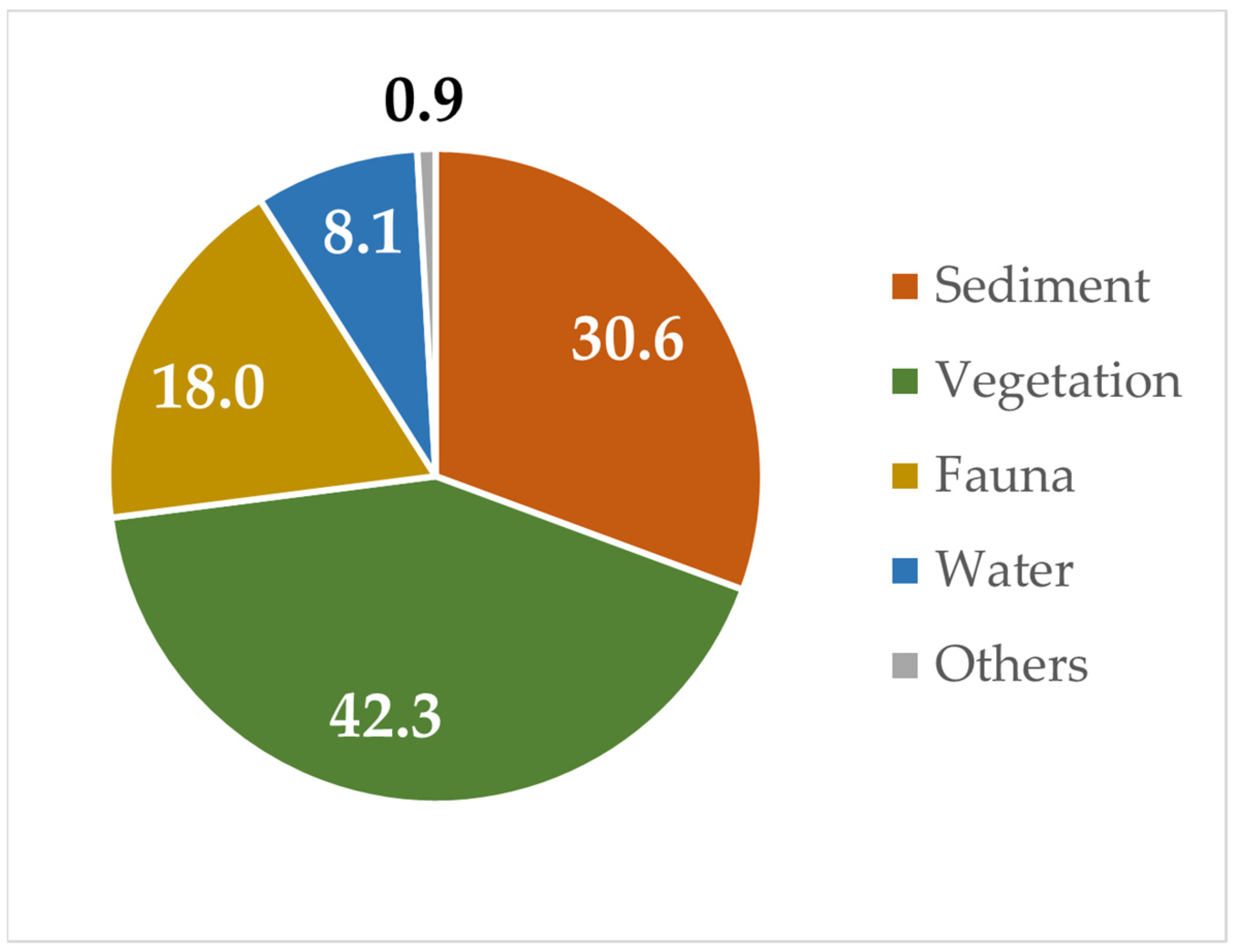Evolution and Effectiveness of Salt Marsh Restoration: A Bibliometric Analysis
Abstract
:1. Introduction
2. Methods
3. Results and Discussion
3.1. Bibliometric Analysis
3.1.1. Publications by Periods
3.1.2. Publications by Country
3.1.3. Analysis of Contents
3.1.4. Bibliometric Analysis after PRISMA Screening
4. Conclusions
Author Contributions
Funding
Data Availability Statement
Conflicts of Interest
References
- McLusky, D.S.; Elliott, M. The Estuarine Ecosystem: Ecology, Threats, and Management; CEUR Workshop Proceedings; Cambridge University Press: Cambridge, UK, 2015; Volume 211. [Google Scholar] [CrossRef]
- Beaumont, N.J.; Jones, L.; Garbutt, A.; Hansom, J.D.; Toberman, M. The value of carbon sequestration and storage in coastal habitats. Estuar. Coast. Shelf Sci. 2014, 137, 32–40. [Google Scholar] [CrossRef]
- Luisetti, T.; Jackson, E.L.; Turner, R.K. Valuing the European “coastal blue carbon” storage benefit. Mar. Pollut. Bull. 2013, 71, 101–106. [Google Scholar] [CrossRef]
- Campagne, C.S.; Salles, J.M.; Boissery, P.; Deter, J. The seagrass Posidonia oceanica: Ecosystem services identification and economic evaluation of goods and benefits. Mar. Pollut. Bull. 2014, 97, 391–400. [Google Scholar] [CrossRef] [PubMed]
- Garrard, S.L.; Beaumont, N.J. The effect of ocean acidification on carbon storage and sequestration in seagrass beds; a global and UK context. Mar. Pollut. Bull. 2014, 86, 138–146. [Google Scholar] [CrossRef]
- Duarte, B.; Carreiras, J.; Caçador, I. Climate Change Impacts on Salt Marsh Blue Carbon, Nitrogen and Phosphorous Stocks and Ecosystem Services. Appl. Sci. 2021, 11, 1969. [Google Scholar] [CrossRef]
- zu Ermgassen, P.S.E.; Baker, R.; Beck, M.W.; Dodds, K.; zu Ermgassen, S.O.S.E.; Mallick, D.; Taylor, M.D.; Turner, R.E. Ecosystem Services: Delivering Decision-Making for Salt Marshes. Estuaries Coasts 2021, 44, 1691–1698. [Google Scholar] [CrossRef]
- Crooks, S.; Schutten, J.; Sheern, G.D.; Pye, K.; Davy, A.J. Drainage and elevation as factors in the restoration of salt marsh in Britain. Restor. Ecol. 2002, 10, 591–602. [Google Scholar] [CrossRef]
- Blott, S.J.; Pye, K. Application of lidar digital terrain modelling to predict intertidal habitat development at a managed retreat site: Abbotts Hall, Essex, UK. Earth Surface Processes and Landforms. J. Br. Geomorphol. Res. Group 2004, 29, 893–905. [Google Scholar]
- French, J.R.; Benson, T.; Burningham, H. Morphodynamics and sediment flux in the Blyth Estuary, Suffolk, UK. In High Resolution Morphodynamics and Sedimentary Evolution of Estuaries; Springer: Dordrecht, The Netherlands, 2005; Volume 8, pp. 143–171. [Google Scholar]
- Billah, M.; Bhuiyan, K.A.; Islam, M.A.; Das, J.; Hoque, A.R. Salt Marsh Restoration: An Overview of Techniques and Success Indicators. Environ. Sci. Pollut. Res. 2022, 29, 15347–15363. [Google Scholar] [CrossRef]
- Broome, S.W.; Seneca, E.D.; Woodhouse, W.W. Tidal salt marsh restoration. Aquatic Botany 1988, 32, 1–22. [Google Scholar] [CrossRef]
- Bakker, J.P.; Esselink, P.; Van der Wal, R.; Dijkema, K.S. Options for Restoration and Management of Coastal Salt Marshes in Europe. 1997. Available online: https://research.wur.nl/en/publications/options-for-restoration-and-management-of-coastal-salt-marshes-in (accessed on 17 October 2021).
- Zhao, Q.; Bai, J.; Huang, L.; Gu, B.; Lu, Q.; Gao, Z. A review of methodologies and success indicators for coastal wetland restoration. Ecol. Indic. 2016, 60, 442–452. [Google Scholar] [CrossRef]
- Kabisch, N.; Frantzeskaki, N.; Pauleit, S.; Naumann, S.; Davis, M.; Artmann, M.; Haase, D.; Knapp, S.; Korn, H.; Stadler, J.; et al. Nature-based solutions to climate change mitigation and adaptation in urban areas: Perspectives on indicators, knowledge gaps, barriers, and opportunities for action. Ecol. Soc. 2016, 21, 39. [Google Scholar] [CrossRef]
- Luedke, H. Nature as Resilient Infrastructure—An Overview of Nature-Based Solutions. EESI, 16 October 2019. Available online: https://www.eesi.org/papers/view/fact-sheet-nature-as-resilient-infrastructure-an-overview-of-nature-based-solutions (accessed on 17 May 2023).
- Cadier, C.; Bayraktarov, E.; Piccolo, R.; Adame, M.F. Indicators of coastal wetlands restoration success: A systematic review. Front. Mar. Sci. 2020, 7, 600220. [Google Scholar] [CrossRef]
- Bertolini, C.; da Mosto, J. Restoring for the climate: A review of coastal wetland restoration research in the last 30 years. Restor. Ecol. 2021, 29, e13438. [Google Scholar] [CrossRef]
- Xiang, H.; Cao, Y. Research on hotspots and evolutionary trends of blue carbon sinks: A bibliometric analysis based on CiteSpace. Environ. Dev. Sustain. 2024, 1–25. [Google Scholar] [CrossRef]
- Poppe, K.L.; Rybczyk, J.M. Tidal marsh restoration enhances sediment accretion and carbon accumulation in the Stillaguamish River estuary, Washington. PLoS ONE 2021, 16, e0257244. [Google Scholar] [CrossRef] [PubMed]
- López-Robles, J.R.; Otegi-Olaso, J.R.; Porto Gómez, I.; Cobo, M.J. 30 years of intelligence models in management and business: A bibliometric review. Int. J. Inf. Manag. 2019, 48, 22–38. [Google Scholar] [CrossRef]
- Cobo, M.J.; Lõpez-Herrera, A.G.; Herrera-Viedma, E.; Herrera, F. SciMAT: A new science mapping analysis software tool. J. Am. Soc. Inf. Sci. Technol. 2012, 63, 1609–1630. [Google Scholar] [CrossRef]
- Page, M.J.; Moher, D.; Bossuyt, P.M.; Boutron, I.; Hoffmann, T.C.; Mulrow, C.D.; Shamseer, L.; Tetzlaff, J.M.; Akl, E.A.; Brennan, S.E.; et al. PRISMA 2020 explanation and elaboration: Updated guidance and exemplars for reporting systematic reviews. BMJ 2021, 372, n160. [Google Scholar] [CrossRef]
- Atkinson, J.; Bonser, S.P. “Active” and “passive” ecological restoration strategies in meta-analysis. Restor. Ecol. 2020, 28, 1032–1035. [Google Scholar] [CrossRef]
- Mcowen, C.J.; Weatherdon, L.V.; Bochove, J.-W.; Van Sullivan, E.; Blyth, S.; Zockler, C.; Stanwell-Smith, D.; Kingston, N.; Martin, C.S.; Spalding, M.; et al. A global map of saltmarshes. Biodivers. Data J. 2017, 5, 11764. [Google Scholar] [CrossRef]
- Adam, P. Salt Marsh Restoration. Coastal Wetlands: An Integrated Ecosystem Approach. In Coastal Wetlands; Elsevier: Amsterdam, The Netherlands, 2019; pp. 817–861. [Google Scholar] [CrossRef]
- Chen, W.B.; Liu, W.C.; Hsu, M.H. Modeling assessment of a saltwater intrusion and a transport time scale response to sea-level rise in a tidal estuary. Environ. Fluid Mech. 2015, 15, 491–514. [Google Scholar] [CrossRef]
- Kirwan, M.L.; Megonigal, J.P. Tidal wetland stability in the face of human impacts and sea-level rise. Nature 2013, 504, 53–60. [Google Scholar] [CrossRef] [PubMed]
- Burden, A.; Garbutt, R.A.; Evans, C.D.; Jones, D.L.; Cooper, D.M. Carbon sequestration and biogeochemical cycling in a saltmarsh subject to coastal managed realignment. Estuar. Coast. Shelf Sci. 2013, 120, 12–20. [Google Scholar] [CrossRef]
- Roe, R.A.L.; Macfarlane, G.R. The potential of saltmarsh halophytes for phytoremediation of metals and persistent organic pollutants: An Australian perspective. Mar. Pollut. Bull. 2022, 180, 113811. [Google Scholar] [CrossRef] [PubMed]
- Agate, J.; Ballinger, R.; Ward, R.D. Satellite remote sensing can provide semi-automated monitoring to aid coastal decision-making. Estuar. Coast. Shelf Sci. 2024, 298, 108639. [Google Scholar] [CrossRef]
- Masselink, G.; Hanley, M.E.; Halwyn, A.C.; Blake, W.; Kingston, K.; Newton, T.; Williams, M. Evaluation of salt marsh restoration by means of self-regulating tidal gate-Avon estuary, South Devon, UK. Ecol. Eng. 2017, 106, 174–190. [Google Scholar] [CrossRef]
- Buchsbaum, R.N.; Catena, J.; Hutchins, E.; James-Pirri, M.-J. Changes in salt marsh vegetation, Phragmites australis, and nekton in response to increased tidal flushing in a New England salt marsh. Wetlands 2006, 26, 544–557. [Google Scholar] [CrossRef]
- Amato, J.; Alberti, J.; Martin, S.; Temple, N.; Sparks, E.; Cebrian, J. Do small-scale saltmarsh planting living shoreline projects enhance coastal functionality? A case study in the Northern Gulf of Mexico. J. Environ. Manag. 2022, 321, 116025. [Google Scholar] [CrossRef]
- Levin, L.A.; Talley, D.; Thayer, G. Succession of macrobenthos in a created salt marsh. Mar. Ecol. Prog. Ser. 1996, 141, 67–82. [Google Scholar] [CrossRef]
- Skov, M.W.; Ladd, C.; Pagès, J.F.; Taylor, B.W.; Paterson, D.M.; Baxter, J.M. Sediment Dynamics of Natural and Restored Bolboschoenus maritimus Saltmarsh. Front. Ecol. Evol. 2019, 1, 237. [Google Scholar] [CrossRef]
- Scarton, F.; Day, J.W.; Rismondo, A.; Cecconi, G.; Are, D. Effects of an intertidal sediment fence on sediment elevation and vegetation distribution in a Venice (Italy) lagoon salt marsh. Ecol. Eng. 2000, 16, 223–233. [Google Scholar] [CrossRef]
- Mcatee, K.J.; Thorne, K.M.; Whitcraft Id, C.R. Short-term impact of sediment addition on plants and invertebrates in a southern California salt marsh. PLoS ONE 2020, 15, e0240597. [Google Scholar] [CrossRef]
- Stagg, C.L.; Mendelssohn, I.A. Restoring Ecological Function to a Submerged Salt Marsh. Restor. Ecol. 2010, 18, 10–17. [Google Scholar] [CrossRef]
- Payne, A.R.; Burdick, D.M.; Moore, G.E.; Wigand, C. Short-Term Effects of Thin-Layer Sand Placement on Salt Marsh Grasses: A Marsh Organ Field Experiment. J. Coast. Res. 2021, 37, 771–778. [Google Scholar] [CrossRef] [PubMed]
- Ford, M.A.; Cahoon, D.R.; Lynch, J.C. Restoring marsh elevation in a rapidly subsiding salt marsh by thin-layer deposition of dredged material 1. Ecol. Eng. 1999, 12, 189–205. [Google Scholar] [CrossRef]
- Cain, J.L.; Cohen, R.A. Using sediment alginate amendment as a tool in the restoration of Spartina alterniflora marsh. Wetl. Ecol. Manag. 2014, 22, 439–449. [Google Scholar] [CrossRef]
- Filipe, L.; Fernandes, S.; Augusto, A.; Pinto, S.; Patrícia, D.; Terêncio, S.; António, F.; Pacheco, L.; Manuel, R.; Cortes, V. Combination of Ecological Engineering Procedures Applied to Morphological Stabilization of Estuarine Banks after Dredging. Water 2020, 12, 391. [Google Scholar] [CrossRef]








| Number of Papers Excluded (From Total 2852) | Reason for Exclusion | Number of Papers Remaining |
|---|---|---|
| 1837 | Not representing the restoration of salt marshes as the focus of the work; having a greater focus on mangroves or genetic or theoretical studies. | 1015 |
| 645 | Studies in the laboratory/mesocosm or mapping work/data collection with a view to a potential restoration action. | 370 |
| 224 | Did not refer to a restoration project carried out by the authors or identified in the publication. | 146 |
| 94 | Did not describe in the methodology the type of intervention that was carried out, or the indicators used to evaluate the success | 62 |
| (A) | |||
| Scope | Indicators | Metrics | N |
| Sediment | Sediment dynamics | Sedimentation rate | 10 |
| Erosion rate | 4 | ||
| Soil aeration | 1 | ||
| Elevation | 19 | ||
| Critical erosion velocity | 1 | ||
| Mass eroded | 1 | ||
| Vertical accretion | 5 | ||
| Sediment characteristics | Bulk density | 9 | |
| Granulometry | 4 | ||
| Clay percentage | 1 | ||
| Silt percentage | 2 | ||
| Hydrodynamics | Flooding duration | 2 | |
| Flooding frequency | 1 | ||
| Drainage | 1 | ||
| Percentage time drained | 1 | ||
| Percentage time flooded | 3 | ||
| Physicochemical characteristics | pH | 6 | |
| Conductivity | 3 | ||
| Redox potential/Eh | 6 | ||
| Greenhouse gas fluxes | 1 | ||
| Salinity | 7 | ||
| Water content | 8 | ||
| Nutrients | Pore water nutrients | 1 | |
| Soluble reactive phosphorus (SRP) | 1 | ||
| Total dissolved nitrogen (TDN) | 1 | ||
| Extractable dissolved organic carbon (DOC) | 1 | ||
| Potentially mineralizable nitrogen (PMN) | 1 | ||
| Extractable ammonium (NH4-N) and nitrate (NO3-N) | 1 | ||
| Total phosphorus (P) | 1 | ||
| Total nitrogen (N) | 1 | ||
| Total carbon (C) | 1 | ||
| Nutrient concentrations | 2 | ||
| Biological | Chlorophyll a | 1 | |
| Carbohydrates | 1 | ||
| Organic matter | 12 | ||
| Microbial biomass nitrogen (MBN) | 1 | ||
| Microbial biomass carbon (MBC) | 1 | ||
| Loss on ignition | 1 | ||
| (B) | |||
| Scope | Indicators | Metrics | N |
| Vegetation | Abundance | Colonization | 7 |
| Cover | 22 | ||
| Vegetation change | 1 | ||
| Species density | 5 | ||
| Species richness | 4 | ||
| Diversity | 15 | ||
| Seedling counts | 2 | ||
| Emergence rate | 1 | ||
| Stem density | 2 | ||
| Shoot density | 1 | ||
| Plant characteristics | Stem high | 2 | |
| Plant height | 3 | ||
| Seed length | 1 | ||
| Health and growth | Health | 3 | |
| Growth rate | 8 | ||
| Belowground biomass | 8 | ||
| Aboveground biomass | 6 | ||
| Biomass | 1 | ||
| Survival rate | 7 | ||
| Processes | Seed production | 2 | |
| Dead stems | 1 | ||
| Live stems | 1 | ||
| Productivity | 1 | ||
| Grazing intensity | 1 | ||
| Photosynthetic rates | 1 | ||
| Entrapped seeds | 1 | ||
| Stomatal conductance | 1 | ||
| Leaf nitrogen | 1 | ||
| Ellenberg indicator values (EIVs) | 1 | ||
| (C) | |||
| Scope | Indicators | Metrics | N |
| Fauna | Abundance | Abundance | 6 |
| Colonization | 1 | ||
| Biomass | 5 | ||
| Density | 7 | ||
| Diversity | 7 | ||
| Species richness | 6 | ||
| Food web | δ13C, δ15N, and δ34S isotope values | 1 | |
| Characteristics | Growth rate | 2 | |
| Size | 1 | ||
| Sex ratio | 1 | ||
| Molting stage | 1 | ||
| Habitat utilization | 2 | ||
| (D) | |||
| Scope | Indicators | Metrics | N |
| Water | Water dynamics | Wave energy | 1 |
| Water table | 1 | ||
| Tidal hydrology | 3 | ||
| Discharge | 1 | ||
| Depth | 3 | ||
| Wave high | 1 | ||
| Physicochemical characteristics | Dissolved oxygen | 1 | |
| pH | 1 | ||
| Salinity | 4 | ||
| Temperature | 1 | ||
| Bottom-water salinity | 1 | ||
| Surface-water temperature | 1 | ||
| Chloride concentration | 1 | ||
| Seston concentration, Chl α, and C/N Ratio | 1 | ||
| Sulfide concentration | 1 | ||
| Sulphate concentration | 1 | ||
| Dissolved organic carbon (DOC) | 1 | ||
| Suspended sediment concentrations (SSC) | 1 | ||
| Secchi depth | 1 | ||
| Typology | Group | N | Success | Failure | Limited | Inconclusive | |
|---|---|---|---|---|---|---|---|
| Natural | Restoration of tidal dynamics | Tidal restriction removal | 1 | 1 | |||
| Breached salt ponds/salt hay farm conversion | 2 | 2 | |||||
| Tidal flow restoration | 2 | 2 | |||||
| Reconnection by breaching/levee removal | 2 | 2 | |||||
| Environmental cleanup | Storm-deposited anthropogenic debris removal | 1 | 1 | ||||
| Infrastructure management | Artificial drainage system neglected | 1 | 1 | ||||
| Dam removal | 1 | 1 | |||||
| Ecological management | Grazing reduction | 1 | 1 | ||||
| Managed realignment | 1 | 1 | |||||
| Assisted | Tidal exchange and hydrological management | Regulated tidal exchange (RTE) system | 1 | 1 | |||
| Increased tidal flushing | 1 | 1 | |||||
| Low tide increased flooding | 1 | 1 | |||||
| Automated hydraulic control gates | 1 | 1 | |||||
| Ecological restoration and management | Invasive species removal | 4 | 4 | ||||
| Vegetation transplants | 13 | 9 | 1 | 2 | |||
| Oyster reefs built | 1 | 1 | |||||
| Living shoreline design that couples breakwalls and oyster restoration structures | 1 | 1 | |||||
| Sediment Management | Sediment fence construction | 1 | 1 | ||||
| Sediment addition | 11 | 8 | 1 | 1 | |||
| Dredged material removal | 1 | 1 | |||||
| Thin-layer sediment placement (TLP) | 3 | 1 | 2 | ||||
| Sediment alginate amendment in plant transplants | 1 | 1 | |||||
| Geomorphological and habitat enhancement | Tidal creeks excavation | 2 | 1 | 1 | |||
| Large-scale biodegradable artificial reefs | 1 | 1 | |||||
| Geomorphological reconstruction of surfaces | 1 | 1 | |||||
| Marsh terracing | 1 | 1 | |||||
| Runnel installations | 1 | 1 | |||||
| Experimental gabion stone and clay-filled terraces | 1 | 1 | |||||
| Microtopographic structures construction | 1 | 1 | |||||
| Control and management of vegetation | Herbicide use | 1 | 1 | ||||
| Reconstructive | Tidal marsh construction and restoration | Constructed tidal marshes | 1 | 1 | |||
| New salt marsh created after the removal of buildings and slurry material | 1 | 1 | |||||
| Soil engineering and revegetation | Soil engineering procedures and revegetation | 1 | 1 | ||||
| Native vegetation planted | 1 | 1 |
Disclaimer/Publisher’s Note: The statements, opinions and data contained in all publications are solely those of the individual author(s) and contributor(s) and not of MDPI and/or the editor(s). MDPI and/or the editor(s) disclaim responsibility for any injury to people or property resulting from any ideas, methods, instructions or products referred to in the content. |
© 2024 by the authors. Licensee MDPI, Basel, Switzerland. This article is an open access article distributed under the terms and conditions of the Creative Commons Attribution (CC BY) license (https://creativecommons.org/licenses/by/4.0/).
Share and Cite
Gonçalves, C.; Fernandes, J.; Neto, J.M.; Veríssimo, H.; Caçador, I.; Verdelhos, T. Evolution and Effectiveness of Salt Marsh Restoration: A Bibliometric Analysis. Water 2024, 16, 1175. https://doi.org/10.3390/w16081175
Gonçalves C, Fernandes J, Neto JM, Veríssimo H, Caçador I, Verdelhos T. Evolution and Effectiveness of Salt Marsh Restoration: A Bibliometric Analysis. Water. 2024; 16(8):1175. https://doi.org/10.3390/w16081175
Chicago/Turabian StyleGonçalves, Carlos, João Fernandes, João M. Neto, Helena Veríssimo, Isabel Caçador, and Tiago Verdelhos. 2024. "Evolution and Effectiveness of Salt Marsh Restoration: A Bibliometric Analysis" Water 16, no. 8: 1175. https://doi.org/10.3390/w16081175





